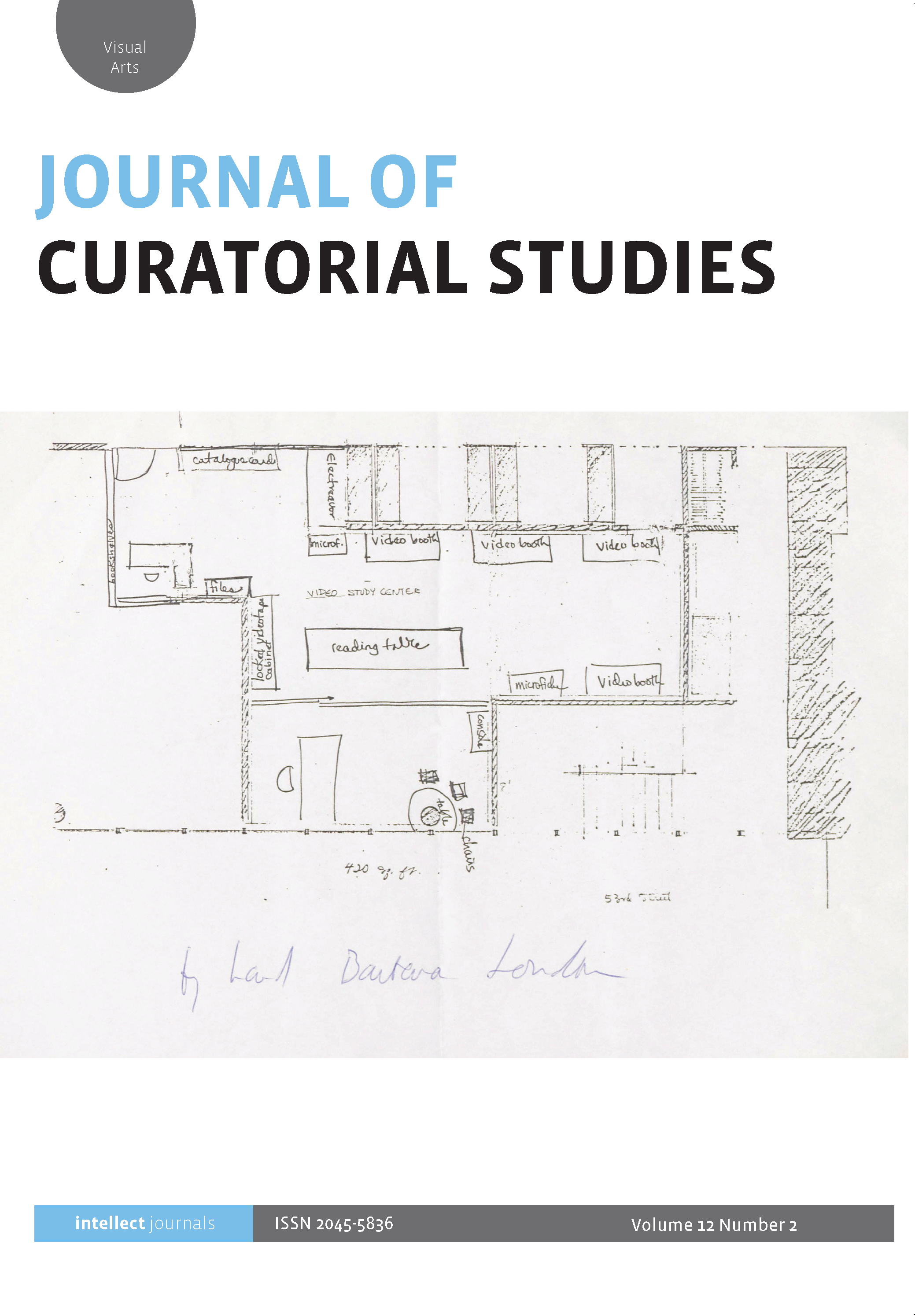- Home
- A-Z Publications
- Journal of Curatorial Studies
- Previous Issues
- Volume 4, Issue 3, 2015
Journal of Curatorial Studies - Volume 4, Issue 3, 2015
Volume 4, Issue 3, 2015
-
-
The Museum of Everyday Life: Objects and Affects of Glorious Obscurity
More LessAbstractSince 2011, the Museum of Everyday Life in Glover, Vermont, has existed as a ‘utopian homemade museum’ housed in a century-old barn. Guided by its curator, the museum draws from collectors, artists and friends to present exhibitions dedicated to ordinary mass-produced objects, often transformed in vernacular fashion. This article contextualizes and analyses the museum’s affective staging of everyday materiality. Drawing on affect theory and object-oriented thought, it examines three aspects of the museum’s practice: the everyday objects it presents and transforms, its playful strategies of display, and the wider networks that link it to pressing political and aesthetic concerns.
-
-
-
What’s Love Got to Do with It? Crowdsourcing, Curating and Love in the Neo-liberal Museum
More LessAbstractUsing the Museum of Fine Art, Boston’s exhibition Boston Loves Impressionism (2014) as a case study, this article engages the problematic ways that the term ‘love’ has been mobilized to promote the ideology and technology of crowdsourcing, diminish the labour of curating and narrow the experience of art viewing. While love might have radical potential, I argue that love is increasingly used as a conservative straightening device enforcing sexual, gender and racial norms and distancing audiences from art and ideas deemed unlovable or foreign. Curating, however, can be mobilized to not merely reproduce a neo-liberal vision of love, but to promote a more inclusive and varied access point for audiences.
-
-
-
Gaming for Affect: Museum Online Games and the Embrace of Empathy
More LessBy Jenny KiddAbstractThis article explores how museum online games encourage affective encounters in players. Video game theory has much to say about affect and empathy as ways into narrative worlds, and this literature is revisited to apply to museums’ games. Through two case studies – Ngā Mōrehu (The Survivors) (2010) from Te Papa Museum in Wellington, New Zealand, and Over the Top (2000) from the Canadian War Museum in Ottawa, Canada – appeals to empathy are scrutinized. Both games encourage players to adopt a first-person perspective within environments characterized by challenge and despair. These examples represent two approaches to game design and raise questions about the technical, educational and curatorial parameters of gaming for affect.
-
-
-
Into Darkness: Affect and Dark Space in Holocaust Exhibitions
More LessAbstractSince 1990, many Holocaust exhibitions have featured dark spaces. This article considers the development of these dark spaces and their display function at two institutions: the Holocaust Exhibition at the Imperial War Museum, London and the United States Holocaust Memorial Museum, Washington DC. By examining shifts in exhibition lighting, a correlation can be found between brighter displays addressing the broad sociopolitical context of Nazism and darker displays focusing more on individual experiences of the death camps. Drawing from phenomenology and museology, this article argues that museums utilize darkness to lead visitors to particular affective experiences and to provoke inquiry into the meanings of the Holocaust.
-
-
-
From Altar to App: Displaying Devotion in the Contemporary Museum
More LessAbstractTraditional museum displays of devotional objects tend to emphasize their status as decontextualized artworks. These displays customarily lack the richer experience of embodiment and the more complex affective responses that are accessible, by contrast, to those visiting historical sites with devotional artefacts in situ. Some museums have nonetheless attempted to counter these limitations by developing exhibition strategies that are more immersive and emotionally engaging. This article examines the recent trend to provide a deeper sense of devotional context, with a particular emphasis on the church of Sant’Agostino, Rome; the St Mungo Museum of Religious Life and Art, Glasgow; the Museum of World Religions, Taipei; and the Victoria and Albert Museum’s redesigned Medieval and Renaissance Galleries. Through a detailed analysis, the article suggests that the most effective (and affective) form of devotional display will activate a less literalist and more lateral encounter that grants visitors the agency to enter into a more evocative ‘third space’ between the artificial environment of the museum and the artefact’s position in the real world.
-
-
-
Exhibition Reviews
More LessAuthors: Friederike Schäfer, Bill Roberts, Negin Zebarjad, Owen Duffy and Jordan MacInnisAbstractALL THE WORLD’S FUTURES Curated by Okwui Enwezor, along with 89 national pavilions and 44 collateral events, 56th International Art Exhibition of la Biennale di Venezia, 9 May – 22 November 2015
ADVENTURES OF THE BLACK SQUARE: ABSTRACT ART AND SOCIETY 1915–2015 Curated by Iwona Blazwick and Magnus af Petersens, Whitechapel Gallery, London, 15 January–6 April 2015
THE AGA KHAN MUSEUM COLLECTION AND THE GARDEN OF IDEAS: CONTEMPORARY ART FROM PAKISTAN Aga Khan Museum, Toronto, 18 September 2014–18 January 2015
SIMON DENNY: THE INNOVATOR’S DILEMMA Curated by Peter Eleey, with Jocelyn Miller, Museum of Modern Art PS1, New York, 3 April–7 September 2015
POLITICS OF FASHION/FASHION OF POLITICS Curated by Jeanne Beker and Sara Nickleson, Design Exchange, Toronto, 18 September 2014–25 January 2015
-
-
-
Book Reviews
More LessAuthors: Alison Cooley and Manisha Aggarwal-SchifelliteAbstractRADICAL MUSEOLOGY: OR, WHAT’S ‘CONTEMPORARY’ IN MUSEUMS OF CONTEMPORARY ART?, CLAIRE BISHOP AND DAN PERJOVSCHI Köln: Walther König (2014), 80 pp., Paperback, ISBN: 978-3-86335-364-3, US $19.95
MUSEUMS AND MIGRATION: HISTORY, MEMORY AND POLITICS, LAURENCE GOURIÉVIDIS (ED.) New York: Routledge (2014), 278 pp., Paperback, ISBN: 978-0-415-83876-4, $51.95
-
-
-
Conference Review
More LessAbstractTHIS IS PARADISE: ART AND ARTISTS IN TORONTO Organized by the Justina M. Barnicke Gallery and the University of Toronto Art Centre, Toronto, 28–31 May 2015
-
Most Read This Month


